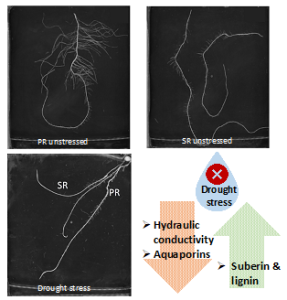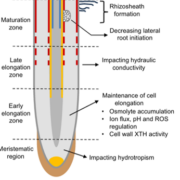Unveiling distinct responses of maize primary and seminal roots under drought stress
 Can you imagine going a day without a sip of water? Neither can plants. Water is essential for supporting diverse physiological processes in plants, including photosynthesis, nutrient transport, temperature regulation, and maintenance of cell turgidity. However, with global increase in temperature and shift in weather patterns, droughts have become increasingly frequent and prolonged that severely impact plant growth and productivity. Plants modulate their root system architecture to sustain their water acquisition capacity under drought stress. In this study, Protto et al investigated the growth pattern and hydraulic response of maize roots subjected to drought stress. Although growth inhibition and reduction in hydraulic conductivity was observed in both primary roots (PR) and seminal roots (SR) under stress conditions, SR were more sensitive to drought stress than PR. Moreover, relative abundance of aquaporins, involved in water transport across cell membranes, declined more in PR than SR under water deficit. Drought stress can also alter suberin and lignin deposition in the root layers, therefore, the authors examined the root anatomy. Suberin and lignin deposition was increased in PR endodermis but not in SR during water deficit. These findings clearly demonstrate distinct anatomical and hydraulic responses among various root types in maize. The unique functional characteristics and developmental plasticity of the maize root system may improve plant resilience in the face of drought stress. (Summary by Abira Sahu @AbiraSahu) Plant Physiol. 10.1093/plphys/kiad675
Can you imagine going a day without a sip of water? Neither can plants. Water is essential for supporting diverse physiological processes in plants, including photosynthesis, nutrient transport, temperature regulation, and maintenance of cell turgidity. However, with global increase in temperature and shift in weather patterns, droughts have become increasingly frequent and prolonged that severely impact plant growth and productivity. Plants modulate their root system architecture to sustain their water acquisition capacity under drought stress. In this study, Protto et al investigated the growth pattern and hydraulic response of maize roots subjected to drought stress. Although growth inhibition and reduction in hydraulic conductivity was observed in both primary roots (PR) and seminal roots (SR) under stress conditions, SR were more sensitive to drought stress than PR. Moreover, relative abundance of aquaporins, involved in water transport across cell membranes, declined more in PR than SR under water deficit. Drought stress can also alter suberin and lignin deposition in the root layers, therefore, the authors examined the root anatomy. Suberin and lignin deposition was increased in PR endodermis but not in SR during water deficit. These findings clearly demonstrate distinct anatomical and hydraulic responses among various root types in maize. The unique functional characteristics and developmental plasticity of the maize root system may improve plant resilience in the face of drought stress. (Summary by Abira Sahu @AbiraSahu) Plant Physiol. 10.1093/plphys/kiad675





